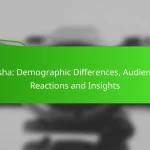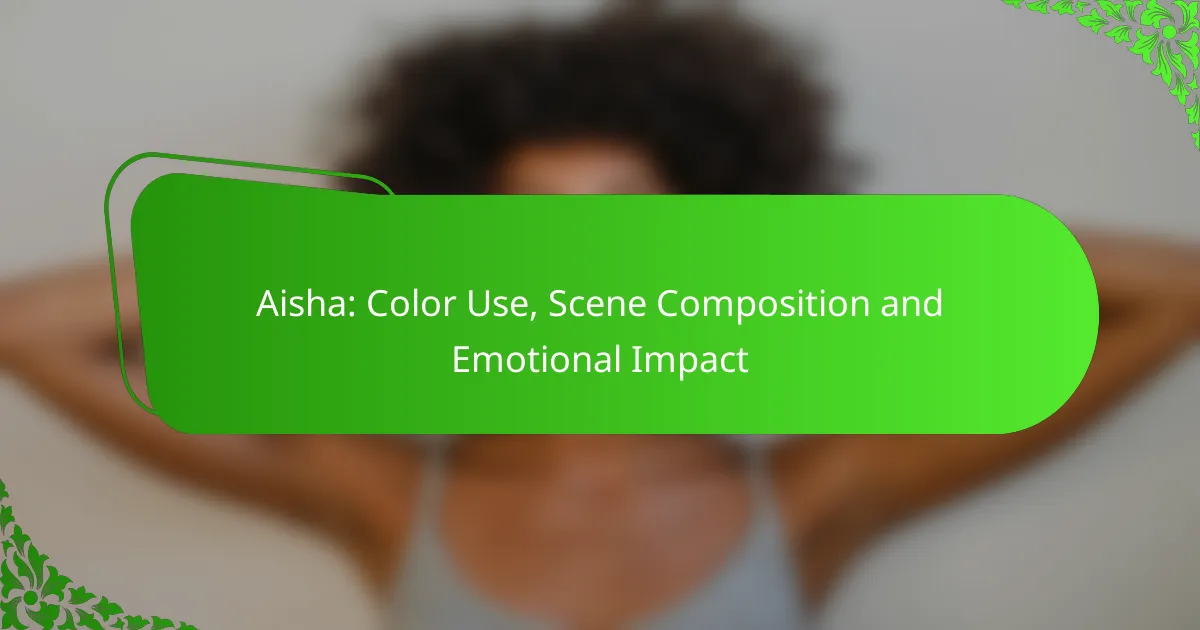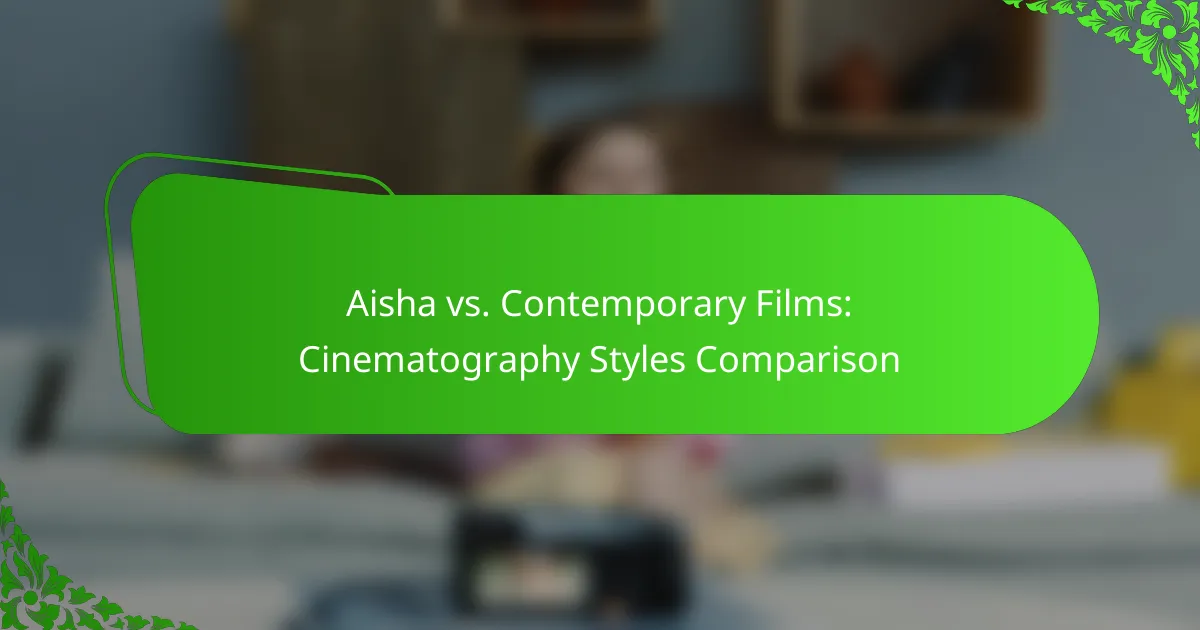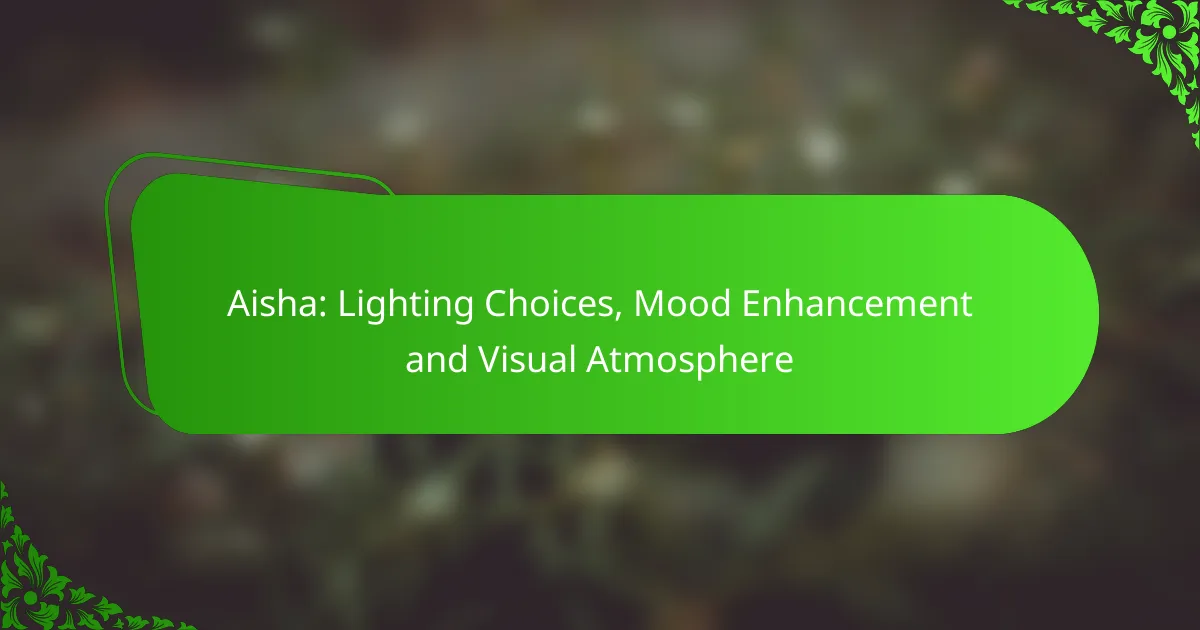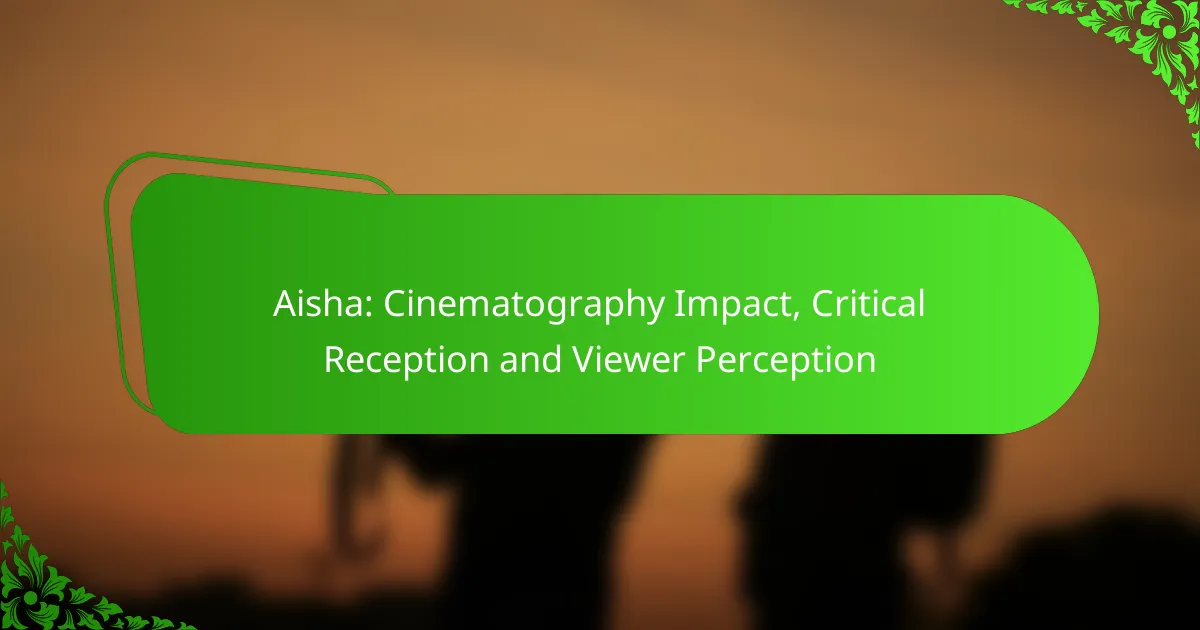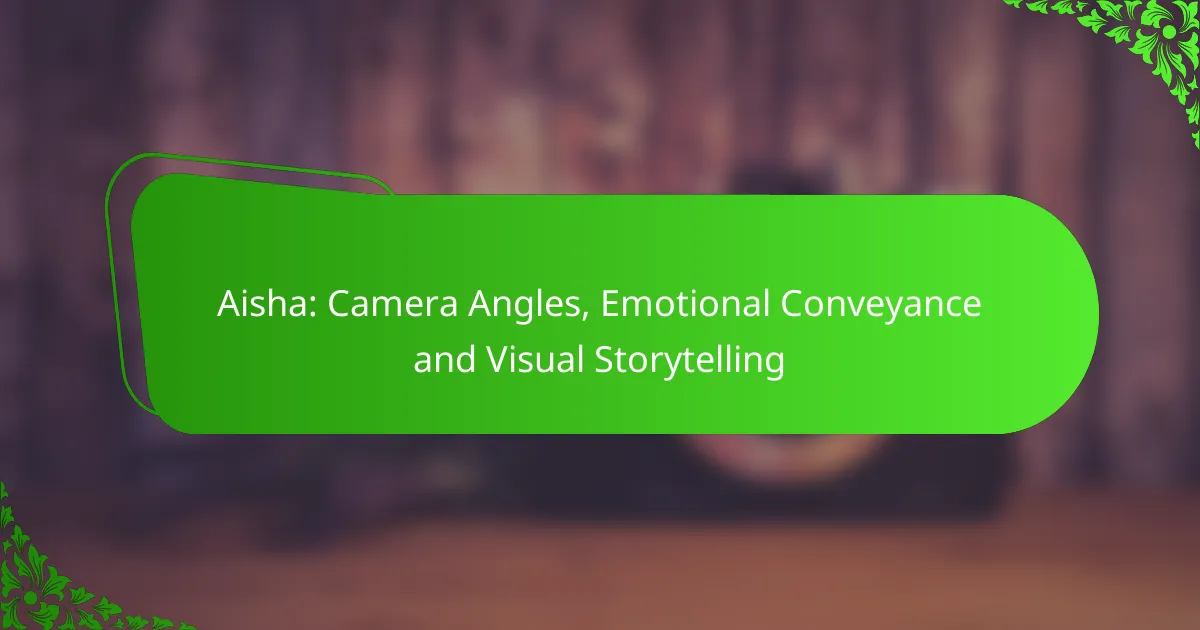Aisha masterfully employs color and scene composition to evoke a profound emotional response in her audience. By choosing specific hues that resonate with particular feelings and utilizing techniques like the rule of thirds and negative space, she creates an immersive emotional landscape that enhances the viewer’s experience. Her deliberate choices guide the audience’s emotional journey, making each piece impactful and memorable.

How does Aisha use color to convey emotions?
Aisha effectively uses color to evoke emotions by selecting hues that resonate with specific feelings. Bright, vibrant colors often express joy, while muted tones can signify sadness, creating an emotional landscape that enhances the viewer’s experience.
Vibrant colors for joy
Vibrant colors such as bright yellows, reds, and greens are often employed by Aisha to convey feelings of happiness and positivity. These colors can create an uplifting atmosphere, drawing the viewer’s attention and sparking feelings of excitement. For example, a scene filled with sunny yellows and lively greens can instantly evoke a sense of cheerfulness.
When using vibrant colors, it’s essential to balance them with other elements to avoid overwhelming the viewer. Pairing bright colors with neutral backgrounds can help maintain focus on the emotional message without distraction.
Muted tones for sadness
Muted tones, including soft blues, grays, and browns, are frequently used by Aisha to express sadness or melancholy. These colors can create a somber mood, allowing the viewer to connect with the deeper emotional themes of the scene. For instance, a landscape painted in shades of gray can evoke feelings of loss or nostalgia.
To effectively convey sadness, Aisha often contrasts muted tones with subtle highlights, which can enhance the emotional depth without losing the overall impact. This technique helps to draw attention to specific elements that may carry significant emotional weight.
Color symbolism in cultural contexts
Aisha’s use of color is also informed by cultural symbolism, where different colors carry distinct meanings across various societies. For example, in many Western cultures, white symbolizes purity and innocence, while in some Eastern cultures, it may represent mourning. Understanding these cultural nuances allows Aisha to communicate complex emotions effectively.
When creating art intended for diverse audiences, it’s important to consider how color choices may be interpreted differently. Aisha often researches cultural associations of colors to ensure her work resonates appropriately with her intended audience, enhancing the emotional impact of her scenes.

What are the key elements of scene composition in Aisha?
The key elements of scene composition in Aisha include the rule of thirds, the use of negative space, and layering techniques that create depth. These elements work together to enhance the emotional impact of each scene, guiding the viewer’s attention and evoking specific feelings.
Rule of thirds application
The rule of thirds is a fundamental technique in visual composition that divides the frame into a 3×3 grid. By placing key elements along these lines or at their intersections, Aisha effectively draws the viewer’s eye to focal points, creating a balanced and engaging scene.
For example, positioning a character’s face at one of the intersections can create a more dynamic and appealing image. This method encourages the viewer to explore the entire composition rather than just focusing on the center.
Use of negative space
Negative space refers to the empty areas surrounding the main subjects in a scene. In Aisha, the strategic use of negative space emphasizes the emotional weight of the characters and actions, allowing viewers to focus on the narrative without distraction.
For instance, a character standing alone against a vast background can evoke feelings of isolation or contemplation. This technique can be particularly effective in scenes that aim to convey deep emotions or highlight a character’s internal struggle.
Layering and depth techniques
Layering involves placing multiple elements within a scene to create a sense of depth and dimension. Aisha employs this technique by incorporating foreground, middle ground, and background elements, which adds richness to the visual storytelling.
Using layers can help guide the viewer’s gaze through the scene. For example, a character in the foreground with blurred scenery behind them can create a sense of immediacy and connection, enhancing the emotional impact of the moment.

How does Aisha’s work impact viewer emotions?
Aisha’s work significantly influences viewer emotions through her deliberate use of color and scene composition. By carefully selecting hues and arranging elements within her pieces, she evokes specific feelings, guiding the audience’s emotional journey.
Emotional responses to color choices
Color choices in Aisha’s artwork can elicit a wide range of emotional responses. For instance, warm colors like reds and oranges often evoke feelings of warmth and passion, while cooler tones such as blues and greens can create a sense of calm and tranquility. Understanding the psychological effects of color can enhance the viewer’s connection to the artwork.
Artists can leverage color theory to intentionally provoke emotions. For example, using contrasting colors can create tension, while harmonious palettes may foster serenity. Aisha’s strategic application of these principles helps viewers engage more deeply with her work.
Scene composition effects on mood
The composition of a scene plays a crucial role in shaping the viewer’s mood. Aisha often employs techniques such as balance, symmetry, and focal points to guide the viewer’s eye and influence their emotional experience. A well-composed scene can evoke feelings of stability or chaos, depending on the arrangement of elements.
For instance, a balanced composition may instill a sense of peace, while an asymmetrical layout can create tension. By manipulating these compositional elements, Aisha enhances the emotional impact of her pieces, making them resonate more profoundly with the audience.
Case studies of viewer reactions
Analyzing viewer reactions to Aisha’s work reveals the profound emotional impact her art can have. In one case, a series of paintings featuring vibrant colors and dynamic compositions led viewers to express feelings of joy and excitement. Feedback indicated that the colors sparked nostalgia and personal memories.
Conversely, a more subdued palette in another series prompted reflections on melancholy and introspection. These varied responses highlight how Aisha’s artistic choices can evoke distinct emotions, demonstrating the powerful connection between art and viewer sentiment.

What frameworks can enhance understanding of Aisha’s techniques?
Understanding Aisha’s techniques can be significantly enhanced by applying frameworks such as color theory and composition guidelines. These frameworks provide essential insights into how color choices and scene arrangement influence emotional responses and narrative depth.
Color theory principles
Color theory principles are fundamental in analyzing Aisha’s use of color to evoke emotions. For instance, warm colors like red and orange can create feelings of excitement or warmth, while cool colors such as blue and green often convey calmness or sadness. Aisha skillfully employs these principles to align the emotional tone of her scenes with the narrative context.
When selecting colors, consider the psychological impact they may have on viewers. A common approach is to use complementary colors to create contrast and draw attention, or analogous colors for harmony and unity. This strategic use of color can enhance the viewer’s emotional engagement with the artwork.
Composition guidelines
Composition guidelines help in structuring visual elements to guide the viewer’s eye and convey meaning effectively. Aisha often utilizes the rule of thirds, placing key subjects along intersecting lines to create balance and interest. This technique draws attention to focal points while maintaining a dynamic flow within the scene.
Another important aspect of composition is the use of leading lines, which can direct the viewer’s gaze toward the main subject. Aisha frequently incorporates natural lines, such as roads or rivers, to enhance the narrative and emotional impact of her scenes. Ensuring that elements are well-placed can significantly affect how the viewer interprets the artwork.
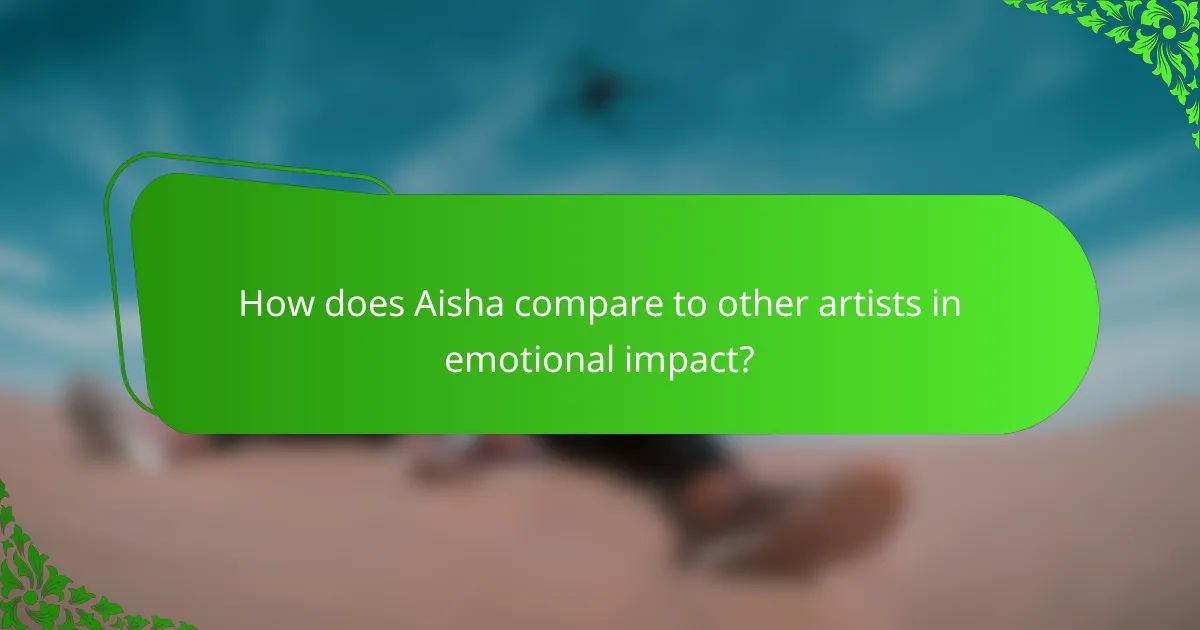
How does Aisha compare to other artists in emotional impact?
Aisha’s emotional impact is distinct, characterized by her unique use of color and scene composition, which often evoke deep feelings. Compared to other artists, her work resonates with viewers through a blend of vibrant hues and thoughtful arrangements that convey complex emotions.
Aisha vs. Frida Kahlo
Aisha and Frida Kahlo both explore personal and emotional themes, but their approaches differ significantly. Kahlo’s work often reflects her own pain and identity struggles, using symbolic imagery and a darker color palette to evoke strong emotions. In contrast, Aisha employs bright colors and dynamic compositions that invite viewers to experience a range of feelings, from joy to introspection.
While Kahlo’s art is deeply autobiographical, Aisha’s pieces tend to focus on universal themes, allowing for broader interpretations. This difference in perspective can influence how audiences connect emotionally with their works.
Aisha vs. Vincent van Gogh
Aisha’s emotional impact can also be compared to that of Vincent van Gogh, who is renowned for his expressive use of color and brushwork. Van Gogh’s swirling skies and vibrant landscapes convey intense emotions, often reflecting his inner turmoil. Aisha, however, utilizes a more contemporary approach, blending colors in ways that create a sense of harmony and balance, which can evoke a more uplifting emotional response.
Both artists effectively use color to communicate feelings, but Aisha’s compositions often focus on clarity and connection, while van Gogh’s work tends to emphasize chaos and struggle. This distinction can affect how viewers interpret and feel about their art, with Aisha’s pieces often leaving a sense of hope and positivity.
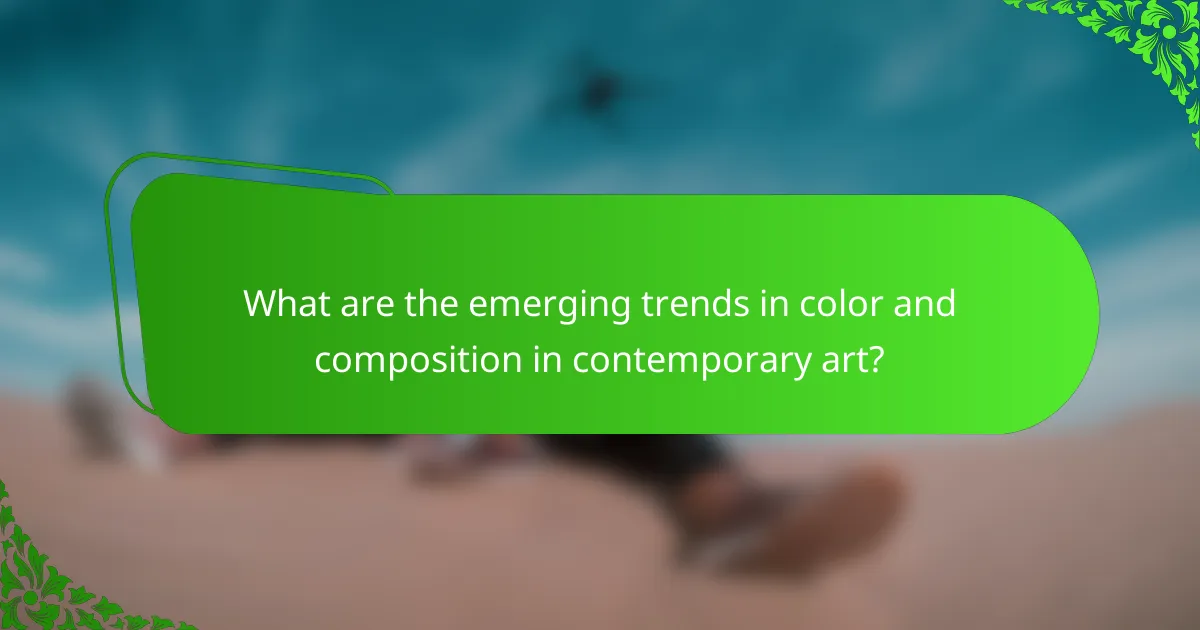
What are the emerging trends in color and composition in contemporary art?
Emerging trends in color and composition in contemporary art emphasize the use of bold colors, innovative techniques, and interactive elements that engage viewers. Artists are increasingly blending traditional methods with digital tools, creating dynamic visual experiences that evoke emotional responses.
Digital art influences
Digital art is reshaping how color and composition are approached, allowing artists to experiment with vibrant palettes and complex layering techniques. Tools like graphic design software enable the manipulation of colors in ways that were previously impossible, leading to striking visual effects.
For instance, artists can create gradients and textures that shift based on viewer interaction, enhancing emotional engagement. This trend encourages a departure from static compositions, inviting audiences to explore art through a digital lens.
Interactive installations
Interactive installations are becoming a significant trend, as they incorporate audience participation to influence color and composition. These works often use technology to change visual elements in real-time, creating a personalized experience for each viewer.
For example, installations might use sensors to alter lighting or color based on movement, fostering a deeper emotional connection. Artists must consider how these interactions affect the overall composition and the viewer’s experience, ensuring that the emotional impact remains strong.
Cross-cultural color interpretations
Cross-cultural interpretations of color are increasingly prominent in contemporary art, as artists draw from diverse backgrounds to convey meanings and emotions. Different cultures associate colors with unique symbolism, which can significantly influence the emotional impact of a piece.
For instance, while red may symbolize love in one culture, it might represent danger in another. Artists should be mindful of these interpretations to create works that resonate with a global audience, enhancing the emotional depth of their compositions.
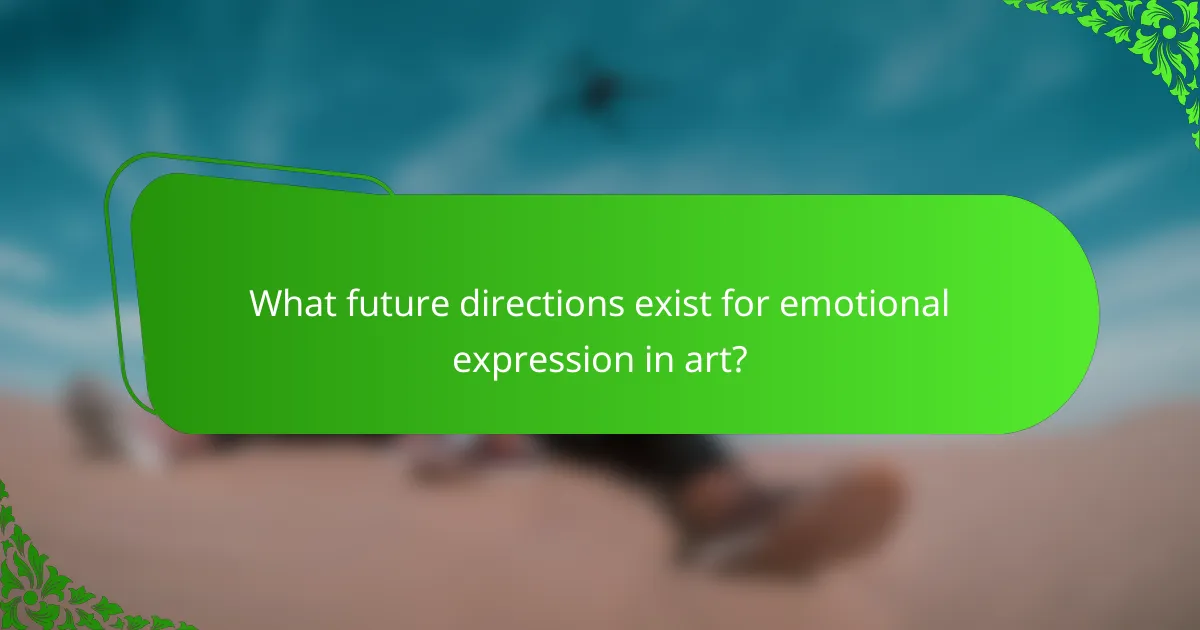
What future directions exist for emotional expression in art?
Future directions for emotional expression in art focus on integrating technology, exploring diverse cultural perspectives, and emphasizing personal narratives. Artists are increasingly using digital mediums and interactive installations to evoke emotions and engage audiences in new ways.
Integration of Technology
The integration of technology in art allows for innovative emotional expression through virtual reality, augmented reality, and interactive installations. These mediums can create immersive experiences that evoke strong emotional responses by placing viewers in dynamic environments.
For example, virtual reality art can simulate experiences that resonate deeply with viewers, such as empathy for others’ struggles or joy in shared moments. Artists should consider how technology can enhance their storytelling and emotional impact.
Diverse Cultural Perspectives
Exploring diverse cultural perspectives in art enriches emotional expression by introducing varied themes, symbols, and narratives. Artists can draw from their own backgrounds or collaborate with others to create works that reflect a broader range of human experiences.
For instance, incorporating traditional motifs from different cultures can evoke specific emotions tied to those traditions. Artists should be mindful of cultural sensitivity and authenticity when representing diverse perspectives.
Emphasis on Personal Narratives
Emphasizing personal narratives in art allows for genuine emotional expression that resonates with audiences. Artists can share their own stories, struggles, and triumphs, creating a connection with viewers who may relate to similar experiences.
Using autobiographical elements can make art more relatable and impactful. Artists should consider how their unique experiences can inform their work and invite audiences to engage with their narratives on a personal level.


